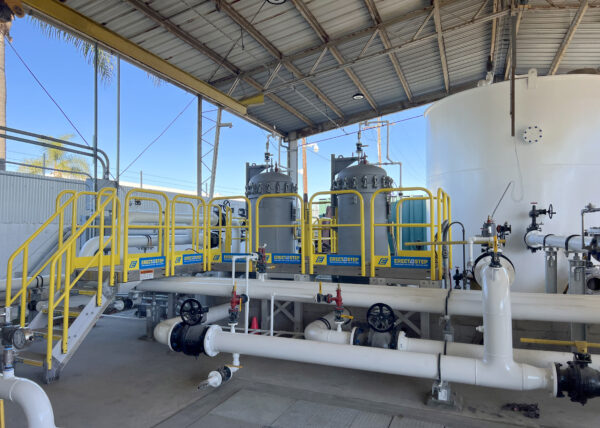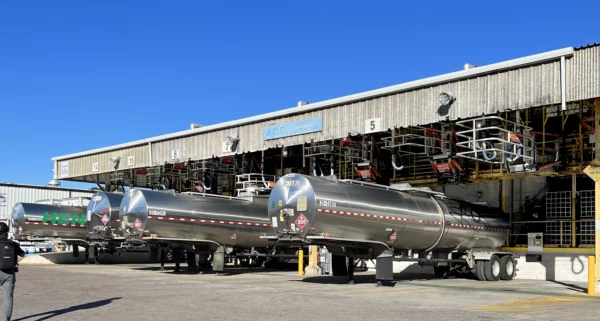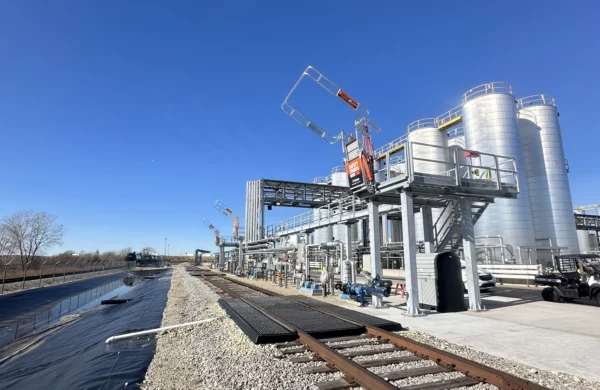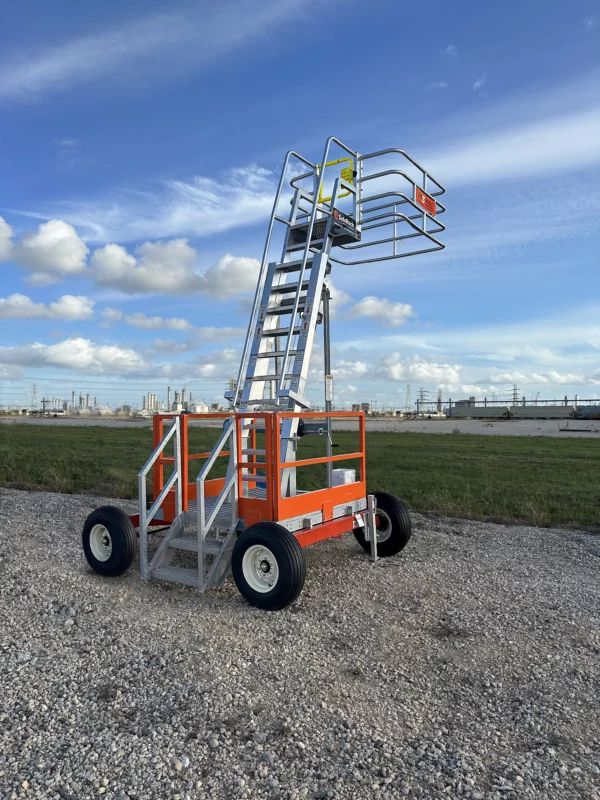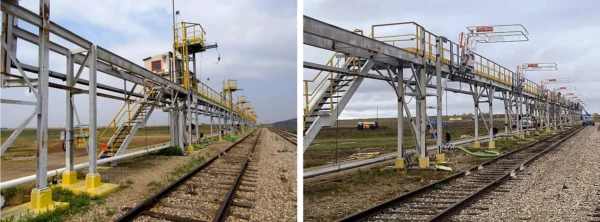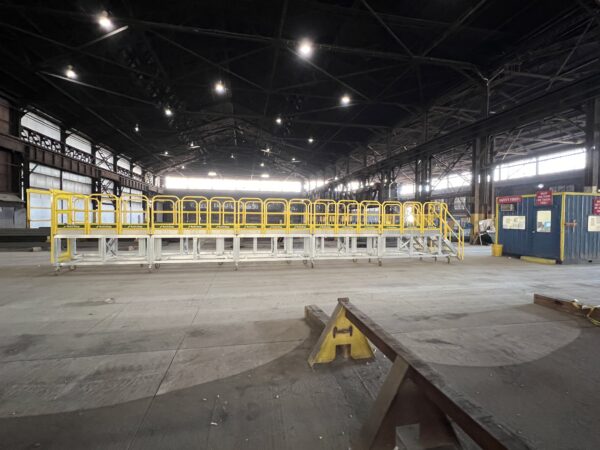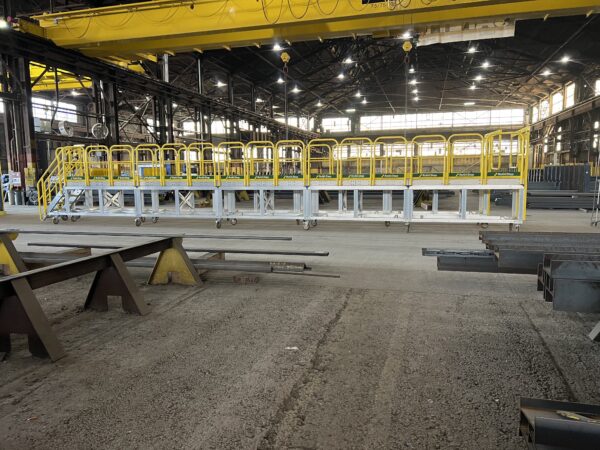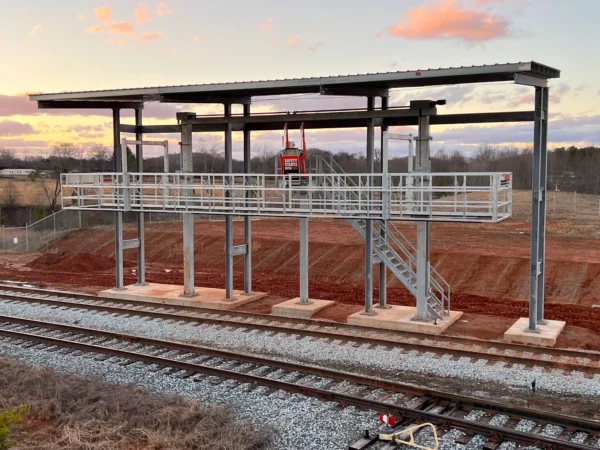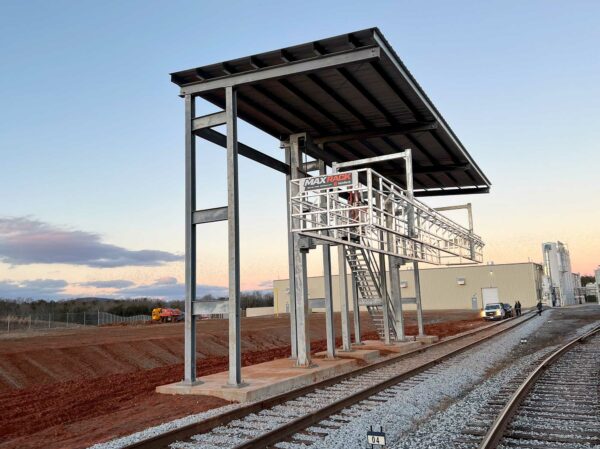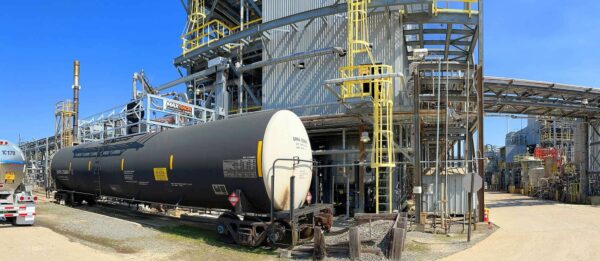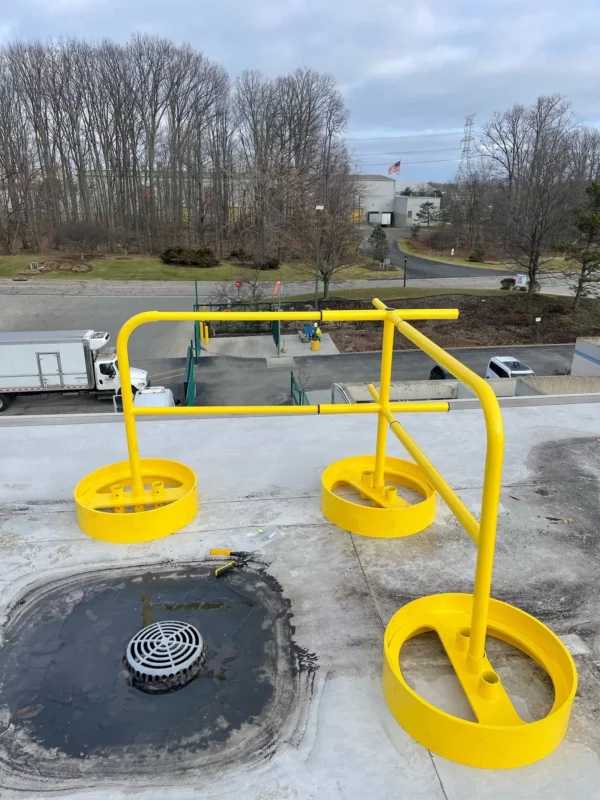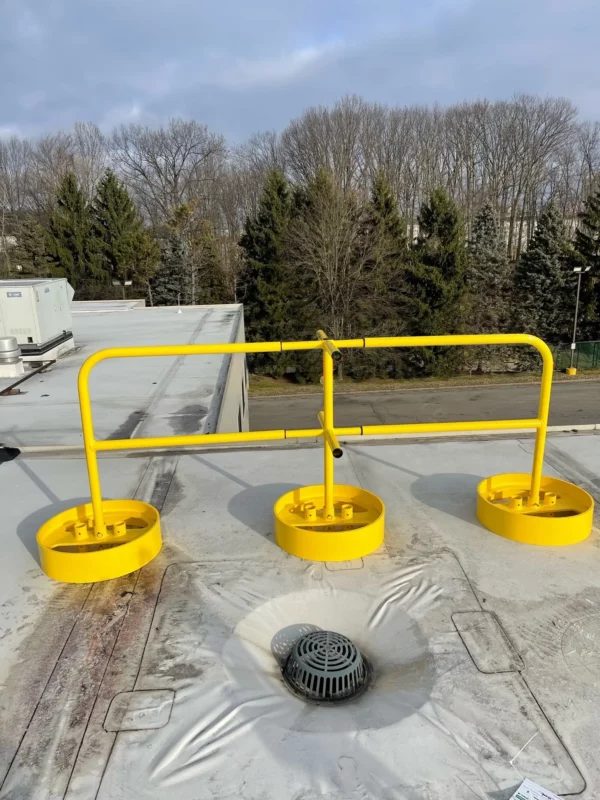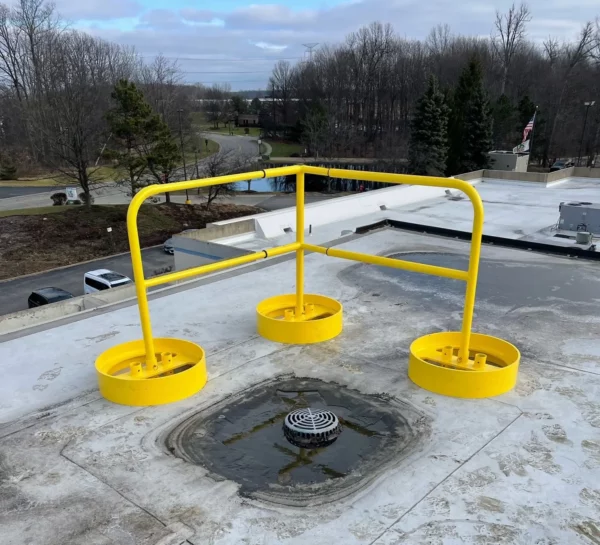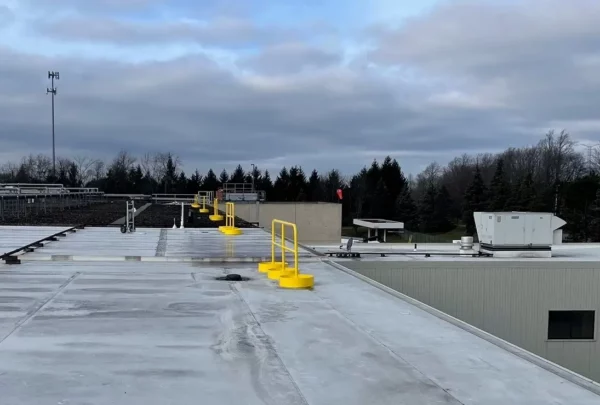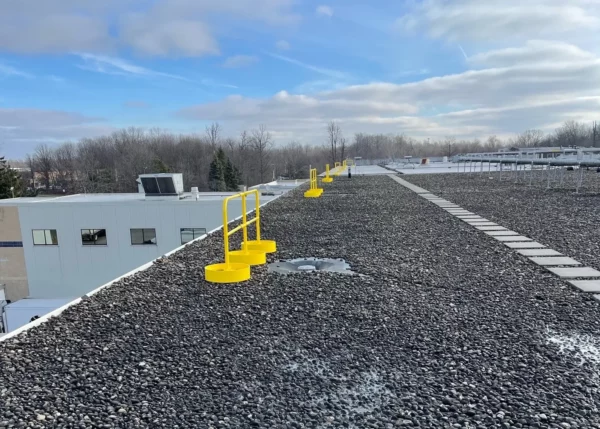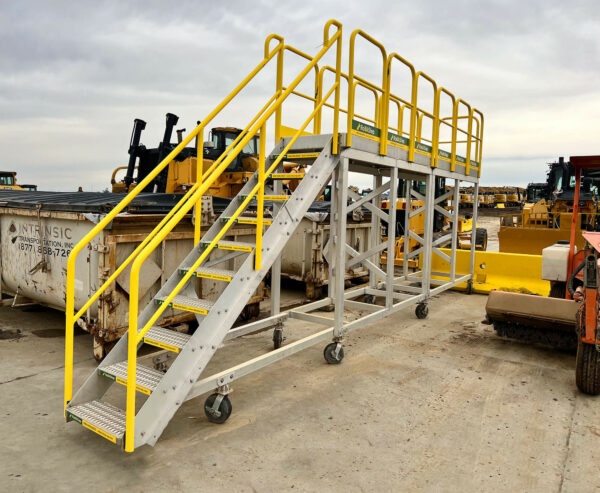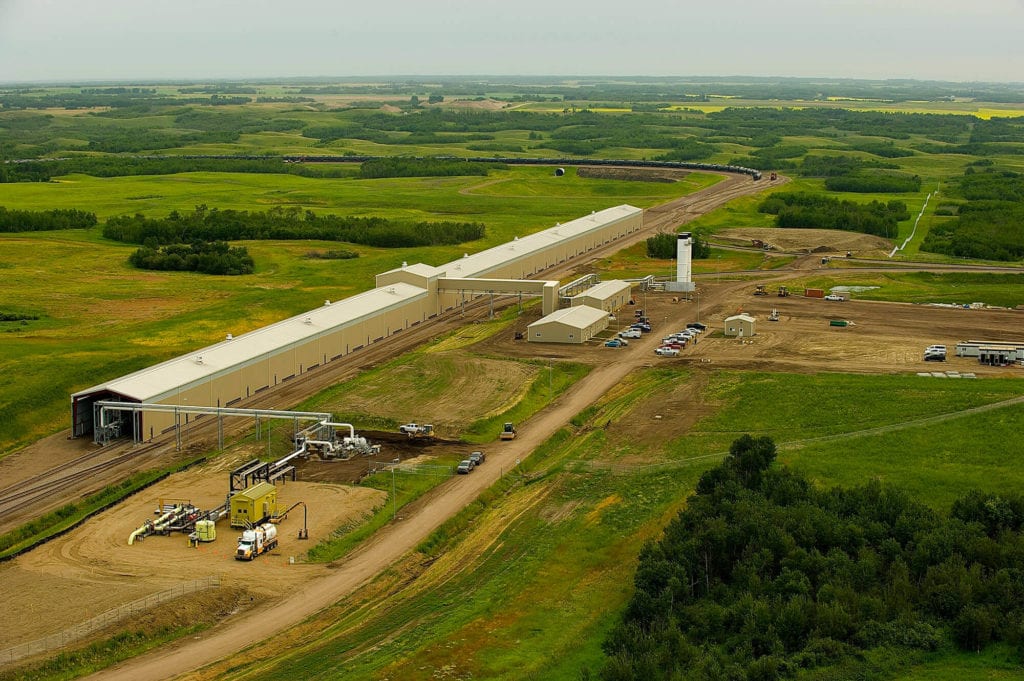Get a quote, configure a custom safety solution or ask a question. We're here to help!








- Spill ContainmentMore …Loading Safety CagesMore …
SafeRack Worldwide
We pride ourselves on one-on-one customer service. When you call SafeRack, we'll be there to answer your questions with a combined experience of 400+ years.
Select your region below.- View Products
- Railcar & Truck Loading Platforms
- Gangways & Loading Ramps
- Stairs, Platforms & Ladders
- Mobile Ladders & Platforms
- Loading Arms & Fluid Transfer
- Safety Gates & Traffic Control
- Aviation & Aerospace Access
- Marine Access & Loading
- Grounding & Monitoring
- Spill Containment
- Loading Safety Cages
- Transloaders & Skids
- Shelters & Canopies
- Fall Protection
- Terminal & Speciality
Home / Industries / Bulk Chemical Loading / Methanol LoadingMethanol (CH3OH) Handling Design, Loading, and Installation.
What is Methanol? Methanol, also known as methyl alcohol, has the chemical formula of CH3OH. In the early 20th century it was also referred to as wood alcohol because it was once produced by the distillation of wood. Today it’s mainly produced industrially by hydrogenation of carbon monoxide.
Methanol is a simple alcohol, consisting of a methyl group linked to a hydroxyl group.
It’s a light, colorless and flammable liquid with a distinctive odor, similar to ethanol or drinking alcohol except much more toxic.In the United States, Methanol is typically a “tight-fill” (closed-loop) loading operation and is loaded into rail cars via loading arms. Methanol, if not handled properly can be fatal and Personal Protective Equipment (PPE) is required. Additionally, because operators are on top of the vehicles during the loading process, fall prevention is essential, not only for safety but increases throughput.
















Question, Get a Quote, Live Demo or Request an On-Site Visit
Our experts simplify the complex
View Full TextMethanol is typically transported via barge, tank truck, ISO or up to a 30,000 gallon DOT-111A100W1 unpressurized general service tank car
The rails cars themselves are designed for pressure relief in order to accommodate thermal expansion during transit, similar to transporting ethanol, gasoline, jet fuel, and other distillates. The tank cars typically have a 9′ outside diameter with an overall length of ~47′, with a 6’ x 6′ or 8’ x 8’ centered crash box.
Tank truck (un)loading procedures are similar to railcar applications with the trailers meeting established DOT requirements for hauling methanol or like commodities. Approved DOT trailers include MC 300 thru MC 312, MC 330, and MC 331. All trailers must be equipped with pressure relief valves; and trailers with bottom outlets must be equipped with remote controlled stop valves. Air pressurization of the tanks (air padding) must never be used for methanol unloading.Your Project
Typically, as a starting point, we will need to know answers to these questions for your project
- The Railcar connection locations need flexibility – Do you know what the breadbasket connections look like?
- Are you using liquid and vapor arms/hose as two separate devices or a piggyback arm?
- Is the loading station indoors or outdoors?
- Is the loading area temperature controlled?
- How are you going to spot your railcars
Our highly trained technical sales team will undertake a detailed site survey prior to undertaking any work to check and clarify all dimensions, obstructions, access issues and other salient points. Our challenge is to provide the safest working environment – protecting operators and the equipment – while simultaneously enabling you to improve throughput and productivity.
Your Project Needs
Whether you are looking for a turn-key installation, on-site supervision or a maintenance program, SafeRack is positioned to assist you. We can do as little or as much as you need. Our project management and supervision team is the best in the business at supporting your company’s needs.
- Collaborative Design – Our loading platform specialists will work with you one on one, if you design to design the best loading solution for your specific needs
- Contract review – drawings and associated documents relating to the contract prior to site arrival
- Risk Assessment – Undertaking a site risk assessment
- Shipment Inspection – Detection of any shipping damage or abnormalities
- Material Receiving – Supervised off-loading and transport at site
- Installation Management – Supervised Installations and Coordination
- Start-up & Commissioning – On-site training for both users and maintenance personnel
Loading Arms
Generally speaking, SafeRack recommends rigid pipe loading arms where possible for the following reasons:
- Balanced throughout their movement envelope
- Designed not to hit the ground – protecting the asset and the operator
- Ergonomic – one man operation
- Fitted with manual or actuated valves.
- Fitted with optional purge/vent facilities
- Can be moved into position with ease and left hanging in the air while the operator prepares the tanker connection
- Parked neatly
Hoses require:
- Annual pressure test
- Are difficult to stow neatly when not in use
- Can be dropped
- Can be driven over
- Are very heavy to use if fitted with a valve at the tanker connection point
- Cannot be easily heated or have vent/purge valves fitted to it
- Prone to catastrophic failure
Railcars and trucks can be unloaded from the top or bottom via pump, gravity or syphoning. The preferred method of unloading is pumping from the top via the discharge tube. Due to the increased risk of spillage, syphoning and gravity unloading is only permitted on cars or trucks with bottom safety valves.
Typical Methanol Loading Platform
Quote or discuss your installation.
Start by selecting loading application"*" indicates required fields
Below are some of the loading and unloading solutions for illustrative purposes only. Our experts will work with you and your team for a custom solution to suit your needs.
Methanol Loading Arms

Methanol is typically top loaded into railcars and tank trucks via loading arms with vapor recovery. The current best loading practice is to use an ANSI #150 approved 3” supported boom loading arm or variable reach carbon steel or stainless steel loading arm with vapor recovery. You can install one liquid and one vapor arm, or mount both the liquid and vapor hoses on a single by-pass arm. Dry-break disconnects, as well as, break-away couplings can be fitted near the inlet of the hose or drop tube for additional safety in the event of a premature departure. Methanol (Un)Loading Arms

Railcars and trucks can be unloaded from the top or bottom via pump, gravity, or siphoning. The preferred method of unloading is pumping from the top via the discharge tube. Due to the increased risk of spillage, siphoning and gravity unloading is only permitted on cars or trucks with bottom safety valves. Loading Gangways and Safety Cages

A wider access gangway (48″-60″ is preferable) as it helps improve access and egress to and from the vessel. In addition, a wider gangway will reduce the risk of the operator’s PPE getting caught, torn or damaged, and will improve productivity and safety. Powered gangway solutions are also an option, with both hydraulic and pneumatic solutions being commonly used. Each gangway will be fitted with a two-rail safety cage for the railcar crash box. This will be a centered 6’x6’ safety cage to sit directly over the cashbox. This will provide a safe, secure work environment for your operator when connected to their breathing apparatus

SafeRack’s GX SAS gangways use Retractalok power-assist technology allowing operators to raise or lower effortlessly, light as a feather to lift, and solid as a rock. Tested in the most critical applications, this revolutionary new gangway outperforms all others. Available in multiple lengths and widths.
Learn MoreMAXRack Elevating Safety Cage
 As an alternative to our two and four-rail safety cages, some customers prefer our MAXRack elevating safety cages. The ultimate fall prevention solution engineered to keep operators safe and productive. Designed for both trucks or railcars, and available in multiple cage lengths and widths. Safe, durable, and easy to use. MAXRack is built rock-solid with galvanized steel column supports and lifting arms (cages can be Aluminum, Galvanized, or Stainless Steel depending on application) Available in two power options – Pneumatic Air Drive and Electric Drive (Explosion and Non-Explosion Proof).
As an alternative to our two and four-rail safety cages, some customers prefer our MAXRack elevating safety cages. The ultimate fall prevention solution engineered to keep operators safe and productive. Designed for both trucks or railcars, and available in multiple cage lengths and widths. Safe, durable, and easy to use. MAXRack is built rock-solid with galvanized steel column supports and lifting arms (cages can be Aluminum, Galvanized, or Stainless Steel depending on application) Available in two power options – Pneumatic Air Drive and Electric Drive (Explosion and Non-Explosion Proof).
Learn MoreMarine Access Gangways

Due to the limited number of Methanol producers, 80% of the world’s annual production is transported between continents that require ocean-going transport. Methanol is pumped from dockside side storage tanks into sealed cargo holds of tanker ships. To facilitate safe, secure access and egress from the vessel, SafeRack offers a complete line of marine gangways. Learn More Methanol Eye Wash/Drench Showers

ANSI guidelines state that an Eye Wash/Drench Showers need to be located 10 seconds or 55’ (16.8m) from contaminants or hazardous materials.
Eyewash stations need to be on the same horizontal plane with no obstructions.Therefore, we would propose the installation of a standard combination Drench Shower/Eyewash Unit, which will save limited space and fit easily into any work environment.Methanol Spill Containment

Spill containment pans will be provided at the point of loading operations and is an essential piece of equipment in overall site safety and environmental protection. SafeRack recommends a minimum 20’ long, galvanized steel or composite track pan to mitigate spills. Methanol Grounding

Methanol is a flammable liquid and vapor, industry best practice includes the grounding of all vessels before starting the (un)loading process. - Vehicle grounding and bonding — ensure true grounding before product flow is permitted
- Explosion-proof enclosures — meet or exceed UL, CSA, and Ex requirements
Methanol Safety Gates

Safety Gates will be installed at the top of stairs and any other openings to ensure operator safety at all times.  YellowGate Safety Gates
YellowGate Safety GatesSafeRack’s line of industrial safety gates is the most flexible product on the market with the ability to span openings between 16” and 36” and is field adjustable with nothing more than a wrench. Learn More
Methanol Options

- Lighting – Lighting both over and under the platform will be provided. For overcast days or second shifts, lighting is essential for improved safety and improved productivity.
- Platform & Canopies – Full platform canopies reduce exposure to the elements and improve the safe and productive loading operation from the operator’s perspective.
- Operator Shelter – Depending on your site requirements, consideration should be given to the requirement of an operator or guard building on the loading platform. This can be customized to meet specific site requirements.
- Wheel Chocks – Railcar Wheel Chocks provide fast blocking of all types of railcars and meet OSHA regulations to safely prevent railroad cars from moving during loading or unloading operations. This is a requirement by the Department of Homeland Security.
Personal Protective Equipment PPE Requirements
Eye/Face Protection: Wear chemical safety goggles. A face shield (with safety goggles) may also be necessary.
Skin Protection: Wear chemical protective clothing e.g. gloves, aprons, boots. Coveralls or long sleeve shirts and pants in some operations. Wear a chemical protective, full-body encapsulating suit, and self-contained breathing apparatus (SCBA). Suitable materials include: butyl rubber, neoprene rubber, Viton®, Viton®/butyl rubber, Barrier® – PE/PA/PE, Silver Shield® – PE/EVAL/PE, Trellchem® HPS, Trellchem® VPS, Saranex®™, Tychem® BR/LV, Tychem® Responder® CSM, Tychem® TK. The following materials should NOT be used: natural rubber, polyvinyl chloride. Recommendations are NOT valid for very thin neoprene rubber gloves (0.3 mm or less).
Respiratory Protection: Up to 5 ppm:
(APF = 10) Any chemical cartridge respirator with cartridge(s) providing protection against methanol*; or Any supplied-air respirator*.
*Reported to cause eye irritation or damage; may require eye protection.
APF = Assigned Protection Factor
Gas Monitors: Methanol has a faintly sweet alcohol odor, but it’s rarely detected until it reaches a concentration of 2000 ppm, which is 10 times higher than the safe exposure limit of 200 ppm. Therefore, best practice is for operators to carry a portable gas monitor at all times while working around Methanol.
Recommendations apply only to National Institute for Occupational Safety and Health (NIOSH) approved respirators. Refer to the NIOSH pocket guide to chemical hazards for more information.
Use a local exhaust ventilation and enclosure, if necessary, to control the amount in the air. Consider using a corrosion-resistant exhaust ventilation system separate from other ventilation systems. It may be necessary to use stringent control measures such as process enclosure to prevent product release into the workplace. Use backup controls (e.g. double mechanical pump seals) to prevent the release of this material due to equipment failure. * For illustrative purposes only. Our experts will work with you and your team for a custom solution to suit your needs Customer Reviews
 4 5Dana is one the most wonderful salespeople I have ever dealt with.
4 5Dana is one the most wonderful salespeople I have ever dealt with.My gangway was delivered on the date requested. As a result of buying our gangway through SafeRack, we saved money and received wonderful responses in confirmations and follow ups. These are easily installed and replaced gangways. Dana is one the most wonderful salespeople I have ever dealt with in my 9 years in this position. The dates given for shipment and receiving are always on time and I am given updates throughout the entire process. Three benefits are dealing with SafeRack employees, getting a great gangway, and knowing any questions I have will be answered quickly as not to hold up any order.
By Robert Parras from Buzzi Unicem on 10/2/14 5 5Safety, functionality, well engineered product and good communication.
5 5Safety, functionality, well engineered product and good communication.Safety, functionality, well engineered product and good communication through Gunny Smith, equals a HAPPY LOADING TEAM.
By James Waldrep from LANXESS Corporation on 1/7/13 5 5Designed with safety in mind.
5 5Designed with safety in mind.Salesman got right on it and provided great service. Very fast, received the product needed the following week… does the job very well. Designed with safety in mind.
By Terry Fleming from Glacial Lakes Energy, LLC on 12/22/15 5 5I really enjoyed working with the SafeRack team.
5 5I really enjoyed working with the SafeRack team.John Nance did a marvelous job with me, he always made sure the service was A1 when I had a question, he was always answering right away. I really appreciate working with him on this project. Project was delivered right on time. I really enjoyed working with the SafeRack team.
By Benjamin Houde from Dyno Nobel Canada on 11/8/12 5 5We are really happy with the unit and ordered a second one.
5 5We are really happy with the unit and ordered a second one.So far, we are really happy with the unit and ordered a second one. The drivers feel confident when they are grounded. Dana Hamor was very responsive – even considering the time zone change.
By Vern Bose from Mac & Mac Hydrodemolition Inc. on 1/30/12 5 5Our product was delivered in a timely fashion and met our needs.
5 5Our product was delivered in a timely fashion and met our needs.We needed a handrail for our metal platform and SafeRack delivered again. I would recommend it to others as I believe it is a respectable product. It looks very nice and easy to install.
By Ricky Lloyd from Gulf Coast Pipeline Services on 2/6/20
Methanol 101
Things to know about Methanol
 Methanol is regulated by the U.S. Department of Transportation (DOT) and is classified as a hazardous and flammable material, with the DOT identification number UN 1230
Methanol is regulated by the U.S. Department of Transportation (DOT) and is classified as a hazardous and flammable material, with the DOT identification number UN 1230With 20M tons produced annually, Methanol is a base to other commodity chemicals, including formaldehyde, acetic acid, and a host of other specialty chemicals.
Methanol is used as a solvent and as an antifreeze in pipelines, windshield washer fluid, and as a denaturant for ethanol. It’s also used to help produce biodiesel.
Methanol is highly flammable and toxic and must be stored in a dedicated location, where it is protected from heat or ignition sources. Solutions of methanol containing up to 74% water are still flammable. Methanol is harder to ignite than gasoline and burns at a slower rate with less heat. When ignited Methanol burns with a non-luminescent flame, which may be invisible in bright sunlight. Therefore first responders should be equipped with infrared devices to detect the fire. Temperature control throughout the loading and unloading process is also critical to a safe and efficient process.
Direct ingestion or inhalation of more than 10ml can cause permanent blindness, poisoning of the central nervous system, and death.
OSHA Permissible Exposure Limit (PEL) @ 200 parts per million in an 8-hour day.
Methanol is corrosive to carbon steel alloys in the presence of humidity or water vapors.
Methanol can be transported either by truck, rail, or ISO and “tight fill” loaded or unloaded using a loading arm or chemical hoses w/ dry disconnect fittings.

Is your plant or facility compliant with ANSI, OSHA, and local safety codes? We can help!


EMERGENCY EYEWASHES / SHOWER EQUIPMENT AND THE ANSI/ISEA Z358.1 – 2014 STANDARD
Following eye contact, you must start washing with water immediately to prevent permanent damage. In the event of skin contact, you must start washing with water immediately to prevent slow-healing chemical burns.
Are you aware that ANSI guidelines state that Eye Wash/Drench Showers need to be located 10 seconds or 55′ from contaminates or hazardous materials and located on the same horizontal plane, with no obstructions? If bottom loading/unloading, an additional shower should be located at grade as well. SafeRack provides the above equipment plus much more needed to keep employees safe and expedite bulk chemical loading and unloading.
OSHA Regulation Experts – Does your existing chemical safety equipment or chemical loading systems meet OSHA’s latest requirements? SafeRack’s professional technical sales consultants are available to meet with your team to make recommendations to keep your facility in front of OSHA’s ever-changing country and region-specific standards and regulations, including lifeline and trolley beam fall arrest systems, metal stairs, and access platforms.
Why SafeRack?
The SafeRack approach is a collaborative one. Let’s call it The SafeRack Way. We have, over many years amassed a great deal of experience and understanding of the safety aspects involved in loading road tankers and railcars, as well as the behavioral habits of the operators.

Experts In Chemical Loading
- Acetic Acid
- Acetic Anhydride
- Acetonitrile
- Acrolein
- Acrylic Acid
- Acrylonitrile
- Aluminum Chloride
- Aluminum Sulfate
- Ammonia
- Ammonium Hydroxide
- Ammonium Nitrate
- Aniline
- Benzene
- Benzyl Chloride
- Bromotrifluoromethane
- Butadiene
- Carbon Dioxide
- Caustic
- Chlorine
- Chloroform
- Chlorosulfonic Acid
- DEF (Diesel Exhaust Fluid)
- Diethylene Glycol
- Dimethylformamide
- Dodecylbenzene Sulfonic Acid
- Ethanol
- Ethyl Acetate
- Ethyl Chloride
- Ethylene
- Ethylene Dichloride
- Ethylene Glycol
- Ethylene Oxide
- Ferric Chloride
- Ferrous Chloride
- Hexane
- Hydrochloric Acid
- Hydrofluoric Acid
- Hydrofluorosilicic Acid
- Hydrogen Cyanide
- Hydrogen Peroxide
- Hydrofluoric Acid
- Hypochlorous Acid
- Isopropyl Acetate
- Liquid Argon
- Liquid Nitrogen
- Liquid Oxygen
- Maleic Anhydride
- MDI
- Methanol
- Methyl Chloride
- Methyl Ethyl Ketone
- Methyl Methacrylate
- Methyl Isocyanate
- Molten Sulphur
- Nitric Acid
- Oleum
- Phenol
- Phosphoric Acid
- Phosphorus Oxychloride
- Phosphorus Trichloride
- Polypropylene
- Renewable Diesel
- Sodium Cyanide
- Sodium Hydroxide
- Sodium Hypochlorite
- Styrene Monomer
- Sulfuric Acid
- Sulfur Dioxide
- Titanium Tetrachloride
- Toluene
- Toluene Diisocyanate
- Turpenitne
- UAN (Urea Ammonium Nitrate)
- UREA
- Vinyl Acetate
- Vinyl Chloride
- Xylene
- Zinc Chloride
- Agro-Chemical
- Specialty Chemical
- Petrochemical

North America’s largest loading terminal
World-leading designer, manufacturer, and installer of truck and railcar loading platforms
As one of the primary railcar loading points, Hardisty is one of the major crude oil hubs in North America and a major origination point of pipelines that export to the United States. SCS was asked to supply and construct a SafeRack crude oil loadout terminal spanning nearly half a mile. The USD Hardisty terminal can load up to two 120-railcar unit trains per day and consists of a fixed loading rack with 62 railcar loading positions enclosed, separate control, operator, and mechanical buildings, as well as a unit train staging area and loop tracks capable of holding multiple unit trains simultaneously. SCS also supplied and installed boom-supported loading arms with supply and vapor management systems.

Quick Quote 866-761-7225
LET US DESIGN YOUR SOLUTION TODAY
Our innovative tools provide 3D visualizations and accurate quotes in minutes.
Get Help NowOrder Now 866-761-7225
Questions or Need a Quote?
Chat live with a knowledgeable and friendly safety expert now.

Bob Kashtan
Located in South Carolina

Joey Robinson
Located in South Carolina

Caelin Lacy
Located in South Carolina

Katie Kelly
Located in South Carolina

Amber Graham
Located in South Carolina












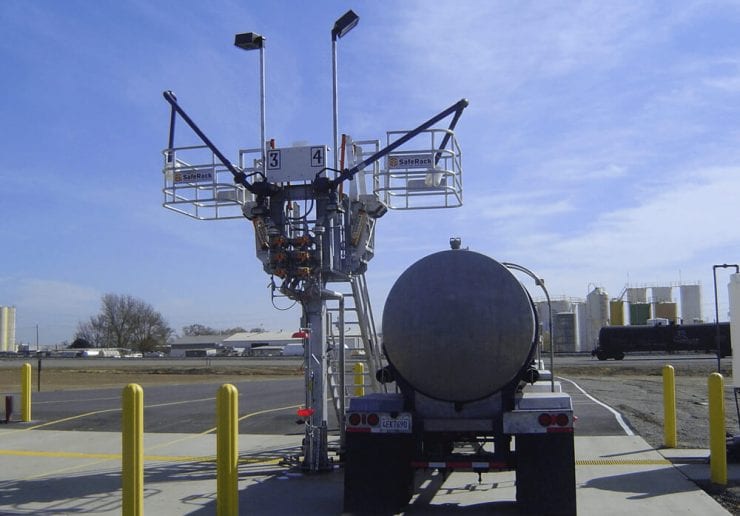
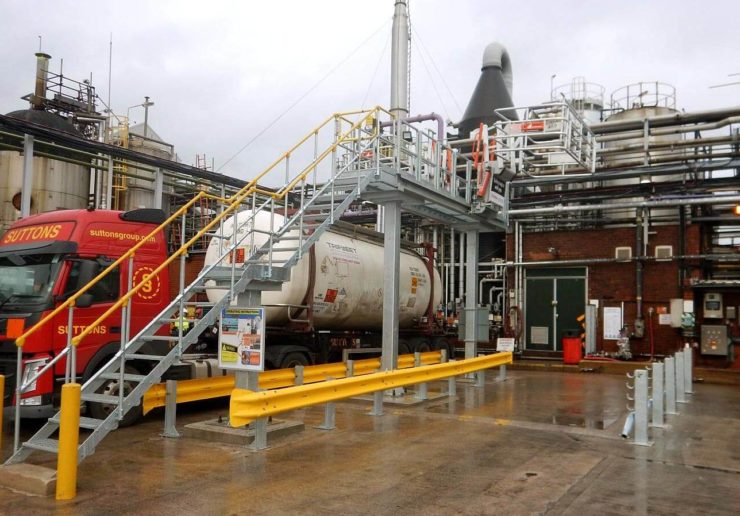
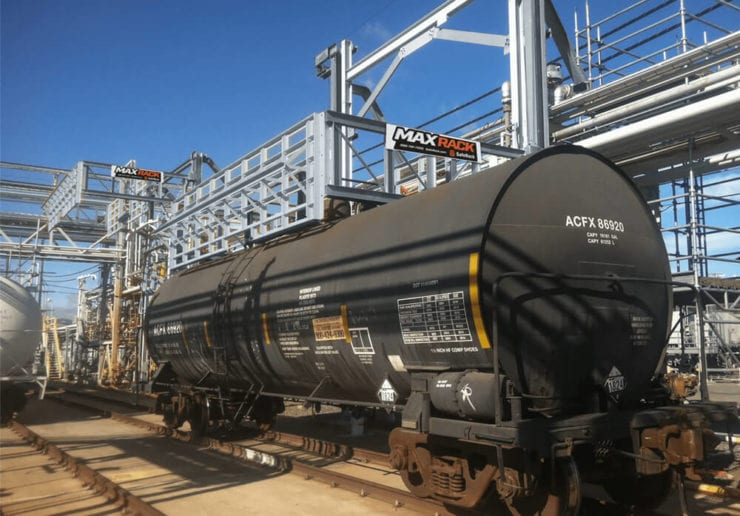


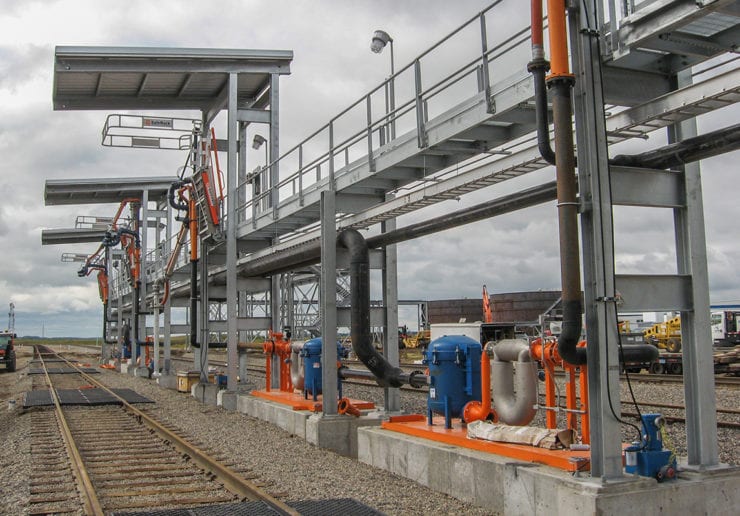

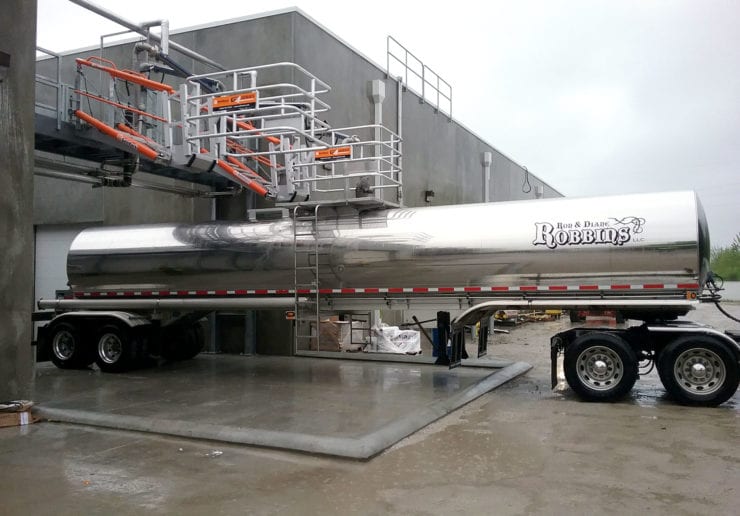
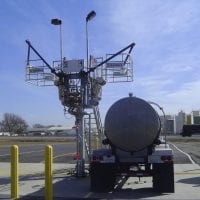
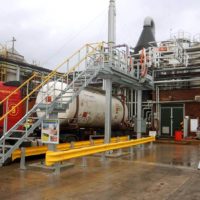
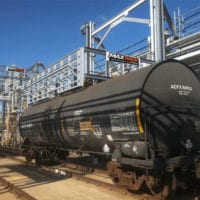
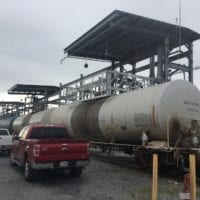
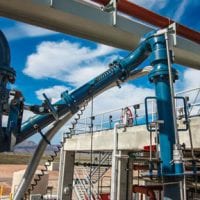
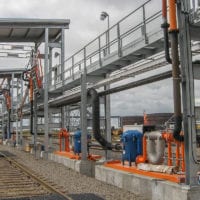



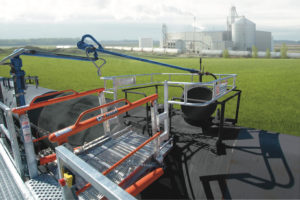
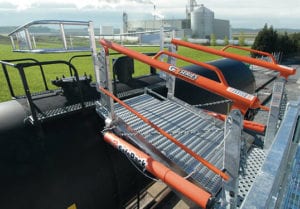
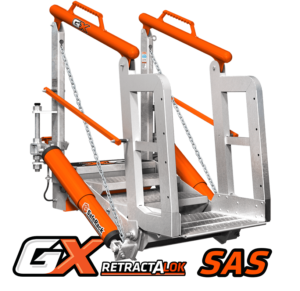
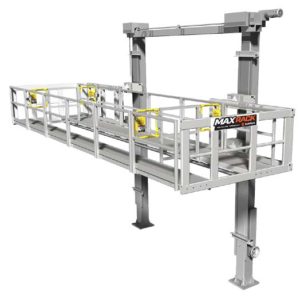 As an alternative to our two and four-rail safety cages, some customers prefer our MAXRack elevating safety cages. The ultimate fall prevention solution engineered to keep operators safe and productive. Designed for both trucks or railcars, and available in multiple cage lengths and widths. Safe, durable, and easy to use. MAXRack is built rock-solid with galvanized steel column supports and lifting arms (cages can be Aluminum, Galvanized, or Stainless Steel depending on application) Available in two power options – Pneumatic Air Drive and Electric Drive (Explosion and Non-Explosion Proof).
As an alternative to our two and four-rail safety cages, some customers prefer our MAXRack elevating safety cages. The ultimate fall prevention solution engineered to keep operators safe and productive. Designed for both trucks or railcars, and available in multiple cage lengths and widths. Safe, durable, and easy to use. MAXRack is built rock-solid with galvanized steel column supports and lifting arms (cages can be Aluminum, Galvanized, or Stainless Steel depending on application) Available in two power options – Pneumatic Air Drive and Electric Drive (Explosion and Non-Explosion Proof).
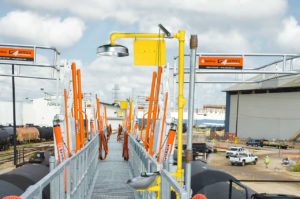
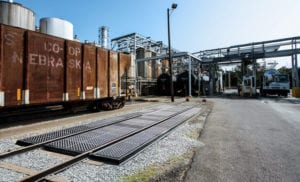
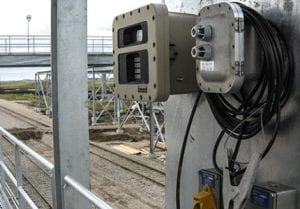
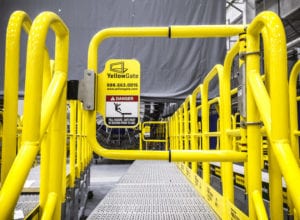
 YellowGate Safety Gates
YellowGate Safety Gates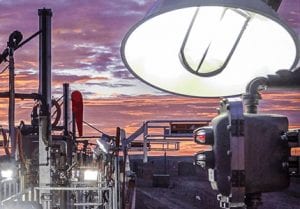







 Methanol is regulated by the U.S. Department of Transportation (DOT) and is classified as a hazardous and flammable material, with the DOT identification number UN 1230
Methanol is regulated by the U.S. Department of Transportation (DOT) and is classified as a hazardous and flammable material, with the DOT identification number UN 1230







